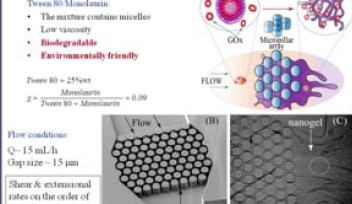Breaking a liquid bridge using torsion
When the upper plate is rotated at 35.5 cycles per second (Hz), the silicone oil bridge is placed under torsion. Such rotation causes a crack to appear that propagates from the edge of the bridge to the center. The video is slowed down to 0.2x speed and takes one second in real-time.
Reporting in a PNAS study, researchers in the Micro/Bio/Nanofluidics Unit have found that twisting is a quicker and cleaner method of breaking liquid bridges. When the upper plate is rotated at 35.5 cycles per second (Hz), the silicone oil bridge is placed under torsion. Such rotation causes a crack to appear that propagates from the edge of the bridge to the center. The video is slowed down to 0.2x speed and takes one second in real-time.
Copyright OIST (Okinawa Institute of Science and Technology Graduate University, 沖縄科学技術大学院大学). Creative Commons Attribution 4.0 International License (CC BY 4.0).
Tags














